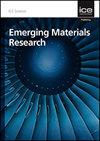缺陷密度对PTAA HTL层量子点太阳能电池性能的SCAPS-1D模拟研究
IF 1.2
4区 材料科学
Q4 MATERIALS SCIENCE, MULTIDISCIPLINARY
引用次数: 1
摘要
近年来,量子点太阳能电池因其作为一种材料具有多功能的电学和光学特性而备受关注。量子点太阳能电池可以根据带隙和尺寸进行调整。本文利用一维太阳能电池电容模拟器(SCAPS-1D)研究了缺陷密度对太阳能电池性能的影响。缺陷密度聚[双(4-苯基)(2,4,6-三甲基苯基)胺](PTAA)/PbS-四丁基碘化铵(PbS-TBAI)和PbS-四丁基碘化铵(PbS TBAI/二氧化钛(TiO2)为1x1010 cm−2至1x1017 cm−2和TiO2的电子迁移率、温度和功函数的变化。这种基于模拟的量子点吸收体太阳能电池在未来可能会被证明是非常有效的量子点太阳能电池。本文章由计算机程序翻译,如有差异,请以英文原文为准。
Simulation study of defect density on the performance of quantum dot solar cell with PTAA HTL layer using SCAPS-1D
In recent years, the quantum dot solar cell has attracted attention due to its versatile electrical and optical properties as a material. The quantum dot solar cell can be tuned in terms of bandgap and size. In the present work effect of defect density on the performance of the solar cell is studied with the help of Solar Cell Capacitance Simulator in one dimension (SCAPS-1D). The defect density Poly[bis(4-phenyl) (2,4,6-trimethyl phenyl)amine] (PTAA)/ PbS- tetra-butyl ammonium iodide(PbS-TBAI) and PbS- tetra-butyl ammonium iodide(PbS-TBAI/ Titanium dioxide(TiO2) is varied from 1x1010 cm−2 to 1x1017 cm−2 and variation of electron mobility of TiO2, temperature and work function is done. This simulation-based quantum dot absorber-based solar cells may, in the future, prove to be extremely effective quantum dot solar cell.
求助全文
通过发布文献求助,成功后即可免费获取论文全文。
去求助
来源期刊

Emerging Materials Research
MATERIALS SCIENCE, MULTIDISCIPLINARY-
CiteScore
4.50
自引率
9.10%
发文量
62
期刊介绍:
Materials Research is constantly evolving and correlations between process, structure, properties and performance which are application specific require expert understanding at the macro-, micro- and nano-scale. The ability to intelligently manipulate material properties and tailor them for desired applications is of constant interest and challenge within universities, national labs and industry.
 求助内容:
求助内容: 应助结果提醒方式:
应助结果提醒方式:


